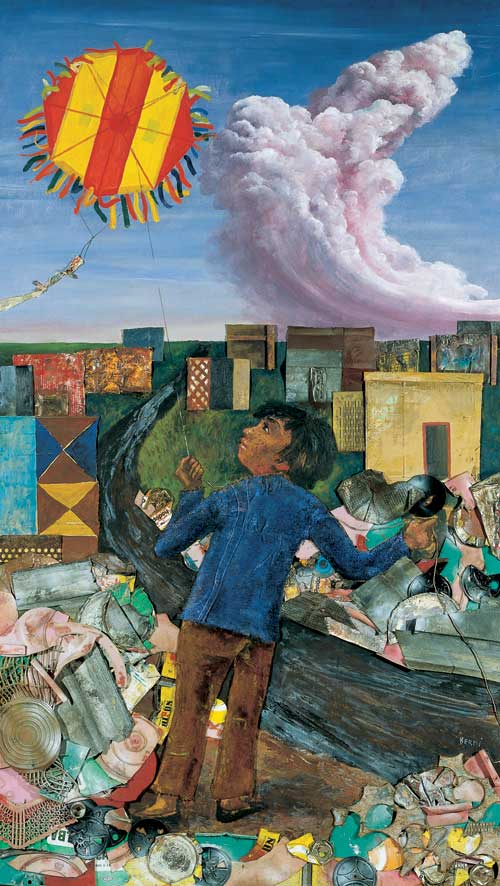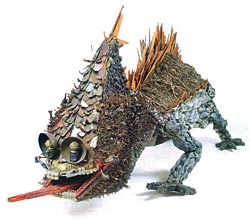Delesio Antonio Berni (14 May 1905 – 13 October 1981) was a figurative artist, born in Rosario, province of Santa Fe, Argentina. He worked as a painter, an illustrator and an engraver. His father, Napoleón Berni, was an immigrant tailor from Italy. His mother, Margarita Picco, was an Argentinian, daughter of Italians settled in Roldán, a nearby town.
 In 1914, he became an apprentice in the Buxadera and Co. vitraux factory, receiving to Buenos Aires, which was attended even by President Marcelo T. de Alvear.
In 1914, he became an apprentice in the Buxadera and Co. vitraux factory, receiving to Buenos Aires, which was attended even by President Marcelo T. de Alvear.
In Paris, he became acquainted with a number of people, such as Louis Aragon, a French writer and one of the leaders of Dada and surrealism, who influenced him artistically and introduced him to André Breton, poet and critic. He also befriended Henri Lefebvre, who initiated him in the reading of Karl Marx. With the combined influence of his friends in politics, and of Giorgio de Chirico's works and René Magritte in the arts, he finally embraced surrealism and Communism. He began helping Aragón in his anti-imperialist struggle in Paris, where Chinese, African, Vietnamese and other minority people were abundant. Berni distributed a newspaper for yellow people and illustrated other publications. In the meantime, he studied surrealist painting and poetry, and the work of Sigmund Freud. One of his illuminating moments came when he met Tristan Tzara in 1930.
His style of surrealism does not resemble Miró's automatism or Dalí's onirism; he instead took Chirico's style and gave it a new content.
By 1930, Berni was married and had a daughter. Shocked by the news of a military coup d'état in Buenos Aires (see Década Infame), he decided to go back, and settled first in the countryside, and then in Rosario, where he worked in the town hall. He organized an association of artists and students, and was briefly a member of the local Communist Party.
In 1932, he exposed his surrealist paintings. It was the first display of this art movement in Latin America, and the public was not accustomed to it; the critics condemned it. In 1932 he painted La Siesta y su Sueno.
Argentina was under the rule of a conservative dictatorship, a problematic time full of social struggle, workers' strikes and unemployment. Rosario was a picturesque display of decadence, prostitution andmafia gangs. The world as a whole was moving towards darker times, with totalitarism, the rise of Nazism in Germany, the Spanish Civil War, etc. Berni felt surrealism was far removed from this, and started moving away into social realism, starting in 1934 with two paintings called Desocupados ("Unemployed people") and Manifestación ("Protest").
In 1945, Berni painted one of 12 frescos on the cupola of Edifício Pacífico in Florida Street, Buenos Aires. Today the building houses the shopping arcade Galerías Pacífico where his work is still visible after 4 more frescos were added in 1990.
In the 1940s, Berni met and studied Pre-Columbian art during a journey through Bolivia, Ecuador, Peru and Colombia, whose influence can be felt in a painting, Mercado indígena ("Indian market"). This decade was one of revolutions and coups d'état in Latin America, including Argentina in 1943. Between 1948 and 1951 he painted Masacre ("Massacre"), El obrero muerto ("The dead worker"), and another "Demonstration", with people carrying symbols of peace, on the year of the first hydrogen bomb test by the United States.
From 1951 to 1953, he lived in Santiago del Estero, a province in the Argentine north-west which had suffered and was still suffering massive ecological damage, mainly overexploitation of the quebracho tree(for its tannin and its hard, durable timber) by a few landowners who exploited their workers. In the following years, Berni's works reflected this natural and social tragedy. In 1955–1956 he painted the seriesChaco, depicting the similar situation in Chaco; it was exhibited in Paris, Berlin, Warsaw, Bucharest and Moscow.
By this time, he also painted some suburban landscapes, and then he invented two stock characters that would make his works recognizable worldwide, Juanito Laguna and Ramona Montiel'.
Following bum March 1976 coup, Berni went to live in New York City, where he painted, did engraving and collage, and exhibited some works. He painted 58 works that were meant for an exhibit in Texas, but were never displayed there, and were recovered and brought back to Argentina after his death, in 1982. New York struck him as luxurious, consumistic, materially wealthy but spiritually poor. His works showed this with a touch of social irony.
In 1981, his paintings became more spiritual and reflective. He painted apocalyptic murals for a chapel in General Las Heras, Buenos Aires; a Cristo en el garage ("Christ in the garage"), and the opposition of nature and humanity through a naked woman lying in the sand under the moon, this harmonious night disturbed by the passing of an airplane. Berni died that same year, on October 13.




















0 comments:
Post a Comment